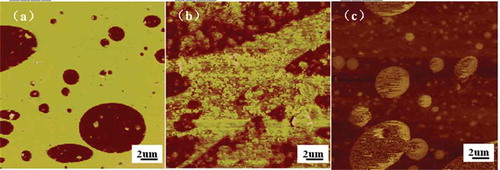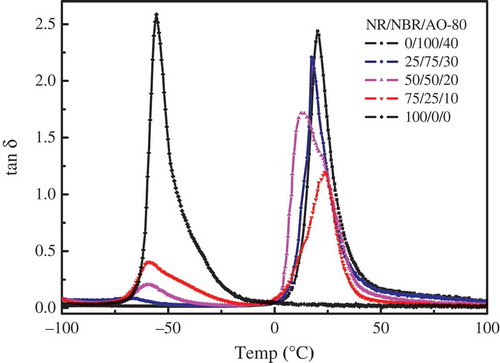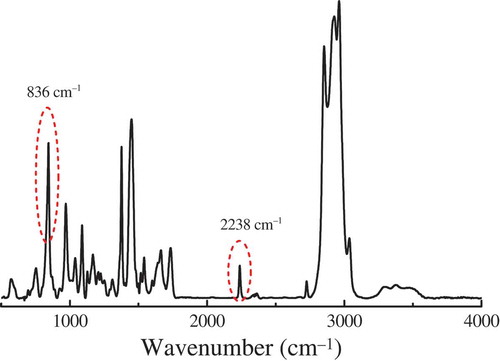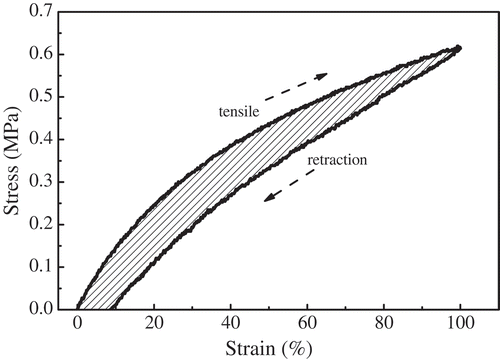Abstract
New natural rubber (NR)/nitrile butadiene rubber (NBR)/hindered phenol (AO-80) composites with high-damping properties were prepared in this study. The morphological, structural, and mechanical properties were characterized by atomic force microscopy (AFM), polarized Fourier transform infrared spectrometer (FTIR), dynamic mechanical thermal analyzer (DMTA), and a tensile tester. Each composite consisted of two phases: the NR phase and the NBR/AO-80 phase. There was partial compatibility between the NR phase and the NBR/AO-80 phase, and the NR/NBR/AO-80 (50/50/20) composite exhibited a co-continuous morphology. Strain-induced crystallization occurred in the NR phase at strains higher than 200%, and strain-induced orientation appeared in the NBR/AO-80 phase with the increase of strain from 100% to 500%. The composites had a special stress–strain behavior and mechanical properties because of the simultaneous strain-induced orientation and strain-induced crystallization. In the working temperature range of a seismic isolation bearing, the composites (especially the NR/NBR/AO-80 (50/50/20) composite) presented a high loss factor, high area of loss peak (TA), and high hysteresis energy. Therefore, the NR/NBR/AO-80 rubber composites are expected to have important application as a high-performance damping material for rubber bearing.
1. Introduction
As highly unexpected natural disasters, earthquakes seriously do damage to human lives and properties. Destruction of buildings is the most direct cause of economic losses and casualties. Rubber bearings, as the most commonly used seismic isolators for buildings, are composed of alternating layers of natural or synthetic rubber bonded to intermediate steel plates [Citation1–Citation4]. Usually, the isolators are set between the foundation and the building structure [Citation5]. It needs not only to carry the weight of the whole building, but also to have a long life (normally more than 70 years). Besides having good damping properties, the rubbers used for isolators must have high flexibility, high elasticity, and high strength [Citation2,Citation5].
Nowadays, natural rubber (NR) is the most widely used material for seismic isolation bearings [Citation6]. NR can bring rubber bearings enough flexibility, which can decrease the earthquake response of buildings. NR also has the advantages of high elasticity, low compression set, and high strength (because of strain-induced crystallization) [Citation7]. Strain-induced crystallization is an important character of NR used in bearings because it can not only prevent the propagation of cracks, but also lead to an increase in the shear stiffness of bearings at high strains, which limit lateral displacements. However, the damping properties of NR cannot meet the requirements for seismic isolation bearings [Citation8]. The horizontal force–displacement relationship for NR bearings is almost linear, and the equivalent damping ratio is only 2%–4% at 100% shear strain, much lower than the 10%–20% for high-damping rubber (HDR) bearing applications. Generally, the loss factor of the rubbers used in seismic isolation bearings should be higher than 0.1, which was tested under the conditions corresponded to the seismic bearing service environment. To enhance the energy dissipation capability of the low damping NR bearings, lead–rubber (LR) bearings are widely used [Citation9]. A LR bearing is similar to an NR bearing, but with an added lead core inserted into a central hole of the bearing. The lead core undergoes plastic deformation and strong energy dissipation during horizontal shaking. However, LR bearings also have some disadvantages; for example, their high-damping properties are useful only for a narrow earthquake frequency range and are not so effective for large deformations. HDR bearings are a new type of rubber bearings in which a new rubber compound, instead of a lead core, is used to provide energy dissipation [Citation10]. Conventional HDR composites contain large amounts of reinforcing fillers such as carbon black and silica. Their hardness and shear modulus are high; thus, high levels of damping are difficult to achieve. No single conventional rubber composite can satisfy all the requirements for HDR bearings. Therefore, the development of a new elastomeric system with high damping, high modulus, and high elasticity is highly desirable.
Because of their excellent damping performance, organic hybrid elastomer composites have become the focus of many studies in recent years [Citation11–Citation13]. In our previous studies [Citation14–Citation16], we prepared a kind of organic hybrid materials with excellent damping properties by adding hindered phenol to the rubber matrix. In particular, the AO-80/NBR rubber composites exhibited high dynamic mechanical losses and high glass transition temperatures depending on the AO-80 content [Citation16]. For the AO-80/NBR (40/100) composite, the temperature ranges in which tanδ > 0.3 and tanδ > 0.1 are 3°C to 35°C and −3°C to 50°C, respectively. At the same time, the nitrile butadiene rubber (NBR) matrix in the composites without filler reinforcement can be oriented under stretching, and the tensile strengths of the composites are above 17 MPa. The NBR/AO-80 composites meet the needs, such as high strength, high damping and high flexibility, of HDR composites for HDR bearings. However, the elasticity of the NBR/AO-80 composites cannot meet the needs of the isolator. As stated above, NR is a material with high elasticity and strain-induced crystallization [Citation17]. If NR and NBR/AO-80 composites are combined, the two components could complement each other to form new composites with properties needed by HDR bearings. In this work, NR/NBR/AO-80 composites with high-damping properties were prepared. The microstructures, crystallization, and orientation under stretching, and damping properties of the new rubber composites were investigated.
2. Experimental
2.1. Materials
NR (smoked sheet #1) was obtained from Nanjing Shengdong Chemical Co., Ltd. (Nanjing, China). NBR (N220S) with an acrylonitrile mass fraction of 41% was provided by Japan Synthetic Rubber Co., Ltd. (Tokyo, Japan). AO-80 (ADK-ATAB-AO-80) in the form of crystalline powder was provided by Asahi Denka Co., Ltd. (Tokyo, Japan). Other chemicals and ingredients were purchased in China. All materials were used without further purification.
2.2. Sample preparation
The NR/NBR/AO-80 rubber composites were prepared according to the following procedures:
2.2.1. NBR/AO-80 mixture
After the as-received NBR was kneaded on a Φ 152.4 mm two-roll mill at room temperature for 3 min, AO-80 was added in the NBR/AO-80 mass ratio of 100/40. The mixture was then kneaded at room temperature for 5 min, further kneaded on the two-roll mill at 135°C for 5 min, and cooled to room temperature. The mixture was then blended at room temperature with compounding and crosslinking additives, consisting of 5.0 phr of zinc oxide, 2.0 phr of stearic acid, 0.5 phr of diphenyl guanidine, 0.5 phr of dibenzothiazole disulfide, 0.2 phr of tetramethylthiuram disulfide, and 2.0 phr of sulfur. Finally, the mixture was kneaded on the two-roll mill at room temperature for 5 min to form the NBR/AO-80 mixture.
2.2.2. NR mixture
The as-received NR was kneaded on a Φ 152.4 mm two-roll mill at room temperature for 3 min. The mixture was then blended with compounding and crosslinking additives, including 3.0 phr of zinc oxide, 1.0 phr of stearic acid, 1.2 phr of N-cyclohexyl-2-benzothiazole sulfenamide, 0.2 phr of tetramethylthiuram disulfide, 1 phr of sulfur, and 2 phr of Antioxidant 4010NA. Finally, the mixture was kneaded on the two-roll mill at room temperature for 5 min to form the NR mixture.
2.2.3. NR/NBR/AO-80 rubber composites
The NR mixture and the NBR/AO-80 mixture in the NR/NBR/AO-80 mass ratios of 100/0/0, 75/25/10, 50/50/20, 25/75/30, and 0/100/40 were kneaded on a Φ 152.4 mm two-roll mill at room temperature for 5 min to form NR/NBR/AO-80 mixtures. These mixtures were then hot pressed and vulcanized at 145°C under the pressure of 15 MPa for various periods of time, and then naturally cooled down to room temperature to form NR/NBR/AO-80 composites. The vulcanization time was pre-determined for each composite by using a disk rheometer (P355C2) purchased from Huanfeng Chemical Technology and Experimental Machine Co. (Beijing, China).
2.3. Analysis and characterization
The morphological, structural, and mechanical properties of the NR/NBR/AO-80 composites were evaluated by using atomic force microscopy (AFM), polarized Fourier transform infrared spectrometer (FTIR), dynamic mechanical thermal analyzer (DMTA), and tensile testing.
The AFM images of representative surfaces of the composites were taken by an AFM (Multimode 8, Bruker, Germany) in the tapping mode. This measurement provided the modulus of the surface depicted as DMT modulus images. The samples were polished at −130°C by using a cryo-ultramicrotome (EM UC7, Leica, Germany) before observation.
Polarized FTIR measurements were conducted on a TENSOR 27 FTIR (Bruker, Germany). The polarized FTIR spectra were acquired by scanning the specimens in the wavenumber range of 400–4000 cm−1 for 32 times with a resolution of 2 cm−1 at room temperature, using the infrared transmittance spectra technique. The FTIR spectra of the NR/NBR/AO-80 rubber composites were acquired from ultra-thin film specimens subjected to uniaxial elongation on a stretching machine mounted in the sample compartment of the spectrometer. During the uniaxial elongation, the interferograms were acquired in small strain intervals with light alternately polarized parallel and perpendicular to the stretching direction.
Tensile tests of the NR/NBR/AO-80 composites were conducted according to ASTM standard (D412: dumbbell-shaped) on a tensile tester (Sans, Ltd., China). The hysteresis losses under stretching of the composites were also measured with the same machine. The specimens (100 mm long, 10 mm wide, and 2 mm thick) were stretched and retracted at a constant rate of 20 mm min−1. At the same time, the stress–strain curves were recorded [Citation18]. The measurements were continued up to four cycles to eliminate the Mullins effect. The hysteresis loss was defined as the area enclosed by the stretch curve and retraction curve.
Dynamic viscoelasticity measurements were carried out on a dynamic mechanical thermal analyzer (DMTA VA3000, 01dB-Metravib Co., Ltd., France). The DMTA specimens were 20 mm long, 6 mm wide, and 2 mm thick. The temperature dependence of the dynamic tensile modulus was measured in the temperature range −100 to 100°C at a frequency of 10 Hz and a heating rate of 3°C°min−1.
3. Results and discussion
3.1. Phase morphology of NR/NBR/AO-80 composites
The morphology of the NR/NBR/AO-80 composites was observed by AFM. As shown in , the lighter regions represent the NBR/AO-80 phase and the darker regions represent the NR phase. When the mass ratio of NR/NBR/AO-80 is 25/75/30, NR is the dispersed phase and NBR/AO-80 is the continuous phase (see (a)). However, at an NR/NBR mass ratio of 50/50, the composite exhibits a co-continuous morphology (see (b)). The NR phase becomes the continuous phase with further increases in the amount of NR, as shown in (c). The particle size of the dispersed phase is a few microns. The AFM micrographs show that the NR/NBR/AO-80 composites have a two-phase structure, consistent with the DMTA results shown in . The plot of tanδ versus temperature for each NR/NBR/AO-80 composite presents two distinct loss peaks. The first loss peak at the lower temperature is the glass transition peak of the NR phase; the second loss peak at the higher temperature is the glass transition peak of the NBR/AO-80 phase. The second loss peak shifts slightly to lower temperatures with increasing amount of NR in the composites, probably because there is a partial compatibility between the NR phase and the NBR/AO-80 phase and most of the AO-80 is accumulated in the NBR phase, regardless of the ratio of the NR phase to the NBR/AO-80 phase. The temperature of the loss peak of the NBR/AO-80 phase is the lowest at an NR/NBR/AO-80 ratio of 50/50/20. In other words, the NR/NBR/AO-80 (50/50/20) composite has the best compatibility between the NR phase and the NBR/AO-80 phase, consistent with the AFM results (). The damping properties of the NR/NBR/AO-80 composites will be further discussed later in this article.
3.2. Strain-induced orientation and strain-induced crystallization of NR/NBR/AO-80 composites
Polarized FTIR is a valuable method to study the strain-induced orientation/crystallization of crosslinked rubber [Citation19–Citation22]. The FTIR spectrum of the NR/NBR/AO-80 (75/25/10) composite is shown in . We selected the absorption bands at 836 and 2238 cm−1 to monitor the orientation and crystallization of the NR/NBR/AO-80 composites under strain. The absorption band at 836 cm−1 is attributed to C—H out of plane bending vibration of cis-1, 4-structure of NR; the absorption band at 2238 cm−1, which is the most characteristic absorption bank of NBR, is assigned to the cyano group of NBR [Citation23,Citation24].
shows the FTIR spectra taken with light alternately polarized perpendicular and parallel to the stretching direction under uniaxial elongations as high as 500%. At zero strain, the ‘perpendicular’ spectra and the ‘parallel’ spectra in (a) are exactly the same, indicating that the composite is isotropic. However, with increasing strain (from 100% to 500%), the peaks at 836 cm−1 become higher in the ‘perpendicular’ spectrum than in the ‘parallel’ spectrum, indicating that the functional groups concerned have been oriented. Meanwhile, the peaks shift to 844 cm−1 at the strain of 300% because of the strain-induced crystallization of NR [Citation21].
Figure 4. FTIR polarization spectra of NR/NBR/AO-80 (75/25/10) composite under different uniaxial elongations at (a) 836 cm−1 and (b) 2238 cm−1.
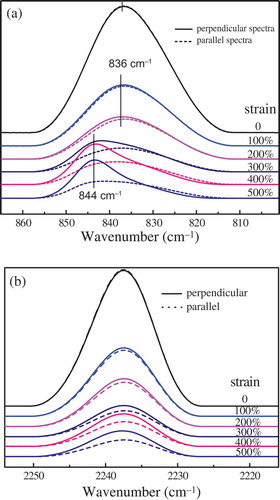
Similarly, as shown in (b), as the strain increases from 0% to 500%, the peaks at 2238 cm−1 in the ‘perpendicular’ spectra are higher than the corresponding peaks in the ‘parallel’ spectra, indicating that the –CN groups are oriented at high strains. That is, strain-induced orientation occurs in the NBR/AO-80 phase of the NR/NBR/AO-80 composites at high strains. Both strain-induced orientation and strain-induced crystallization occur simultaneously in the NR/NBR/AO-80 composites. Moreover, with increasing strain, the bands at 836 and 2238 cm−1 becomes higher in both the ‘perpendicular’ spectra and the ‘parallel’ spectra, and both bands are much lower in the ‘parallel’ spectra than in the ‘perpendicular’ spectra; i.e., both bands are vertical bands [Citation21].
The dichroic function (DF) is often used to evaluate the orientation of composites [Citation25,Citation26]. The DF can be estimated according to the following equation:
where A and A⊥ are the areas of the band in the ‘parallel’ spectrum and ‘perpendicular’ spectrum at a strain, respectively. shows the relationship between the DF and strain of the NR/NBR/AO-80 (75/25/10) composite. As discussed above, the bands at 836 and 2238 cm−1 represent the functional groups of the NR phase and NBR/AO-80 phase of the NR/NBR/AO-80 composites, respectively. The DF of the NBR phase (the band at 2238 cm−1) increases linearly when strain increase from 0% to 500%. However, the DF of the NR phase (the band at 836 cm−1) is not linear. It means that the orientation of NBR molecules began under a small strain. But NR molecules have no significantly change at strains lower than 200%, and the orientation of the NR molecules increase linearly with increasing strain (higher than 200%).
Figure 5. Strain dependence of DF for absorption bands at 836 and 2238 cm−1 of FTIR spectrum of NR/NBR/AO-80 (75/25/10) composite.
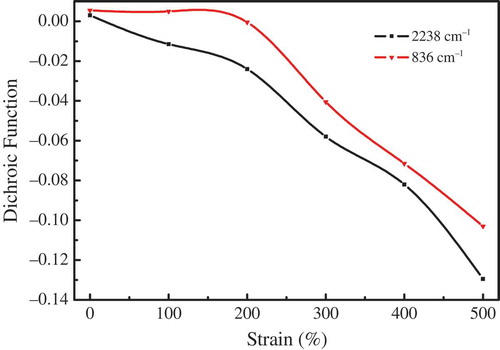
As is well known, the molecular chains of the continuous phase, NR, are very flexible in the NR/NBR/AO-80 composites; however, the molecular chains of the dispersed phase, NBR/AO-80, are rigid because of the strong polarity and hydrogen bonding between NBR and AO-80 [Citation14]. When faced with a low strain, the flexible chains can quickly compensate for the change in internal stress by adjusting the molecular conformation. But the rigid chains can be deformed only by high strain or appropriate molecular chain orientation. That is, the NBR/AO-80 composites are easily aligned and oriented because of the hydrogen bond network. Moreover, the values of DF for both bands decrease with increasing strain, indicating a good stress transfer between the continuous phase and the dispersed phase of the composites. It also can be seen later from the stress–strain curves of the NR/NBR/AO-80 composites ().
Figure 6. Stress–strain curves of NR/NBR/AO-80 composites with different mass ratios of NR/NBR/AO-80.
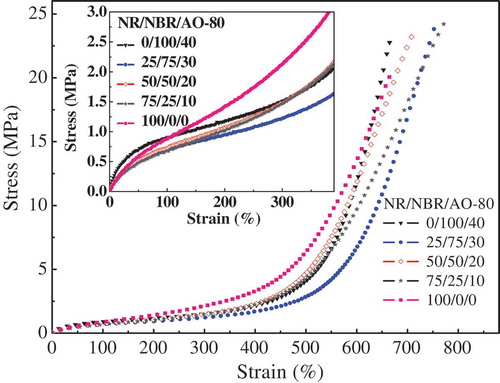
shows the tensile stress–strain curves of the NR/NBR/AO-80 composites with various NR/NBR/AO-80 mass ratios. All the curves show the same trend: the samples had a large deformation (up to 400%) under small stress (about 2 MPa); the stress of the samples increased rapidly when the strain was greater than a certain value (about 500%). It is important that the tensile strength and elongation at break of all the composites are above 20 MPa and 650%, respectively, because the rubber composites used in isolators require the performance of large deformation and low modulus [Citation5,Citation27]. NR has excellent mechanical properties, mainly because of its strain-induced crystallization. As for NBR/AO-80, there is a good compatibility and strong intermolecular interactions between NBR and AO-80, and both of these properties lead to strain-induced orientation [Citation14]. Furthermore, all the NR/NBR/AO-80 composites have similar tensile strengths and elongations at break. We have thus reconfirmed that strain-induced orientation and crystallization occur simultaneously in the two phases of the composites: the NR phase and NBR/AO-80 phase.
3.3. Damping properties of NR/NBR/AO-80 composites
To characterize the energy dissipation and the hysteresis performance of the NR/NBR/AO-80 composites, the hysteresis loop of the tensile stress–strain curve was examined. As shown in , the shaded area surrounded by the tension curve and retraction curve is noted as the hysteresis energy density (HED), representing the consumed energy of the composites during one draw-reply cycle [Citation28].
describes the relationship between the hysteresis energy and the strain of the NR/NBR/AO-80 composites. It can be seen that the hysteresis energy of all composites gradually grows with the strain increasing from 50% to 200%, an indication that the hysteresis loss as well as the damping properties increase. On the other hand, for the same strain, the hysteresis energy increases with increasing content of NBR/AO-80, confirming that the NBR/AO-80 phase improves the damping properties of NR/NBR/AO-80 significantly because of the formation of strong hydrogen bonds between the polar rubber NBR and the organic filler AO-80. The intermolecular interactions greatly increase the frictional damping of molecular motion; as a result, the damping properties of the composites improve [Citation28].
Table 1. Relationship between HED and strain of NR/NBR/AO-80 composites.
The loss factor (tanδ) reflects the external and the internal friction and represents the ratio of the energy dispersed to the energy accumulated in one deformation cycle. shows the temperature dependence of tanδ for the NR/NBR/AO-80 composites with various mass ratios of NR/NBR/AO-80. It indicates that NR has only one tanδ peak with a peak value of 2.6 at about −55°C. For the NBR/AO-80 composites, there is also a single tanδ peak with a peak value of 2.5 at about 20°C. But the NR/NBR/AO-80 composites present two distinct tanδ peaks, corresponding to the NR phase and NBR/AO-80 phase. The working temperature of isolators is the ambient temperature under the building, i.e., 0–40°C. Therefore, the damping property of an NR bearing is poor. The NBR/AO-80 composites have better damping properties than NR in the above working temperature range. With increasing amount of NBR/AO-80, the NR/NBR/AO-80 composites show two tanδ peaks. All the NR/NBR/AO-80 composites show a tanδ peak with a high peak value within the working temperature range.
shows the damping properties of the NBR/AO-80 phase of the NR/NBR/AO-80 composites. With increasing NBR/AO-80 content, the tanδmax of the NBR/AO-80 phase of the NR/NBR/AO-80 composites increases from 1.2 to 2.2, and the temperature of the tanδmax (peak value) is around 20°C. At a ratio of NR/NBR/AO-80 of 50/50/20, the temperature range in which tan δ > 0.1 is 2.8–47.1°C, and the temperature range in which tan δ > 0.3 is 4.4–36.8°C. These temperature ranges are consistent with the working temperature range of seismic isolators [Citation5]. These results show that the NR/NBR/AO-80 composites are better materials than NR for seismic isolators. The TA value, the area under the tanδ versus temperature curve, is commonly used to characterize the damping performance of rubbers. shows that the TA value of NR/NBR/AO-80 composites reaches 38.6°C in the temperature range of −10°C to 50°C with increasing NBR/AO-80 content. The larger the TA value, the better the damping performance of the NR/NBR/AO-80 composite. The NR/NBR/AO-80 (50/50/20) composite has excellent damping properties and mechanical properties in the rubber bearing working temperature range and could be an ideal material for the seismic isolators. For HDR bearings, the equivalent damping ratio or tan δ should be higher than 0.1 in the working temperature [Citation1]. The NR/NBR/AO-80 composites have a broad temperature range in which tan δ > 0.1 and can be good candidates for HDR bearings.
Table 2. Damping properties of NR/NBR/AO-80 composites with various mass ratios of NR/NBR/AO-80.
4. Conclusions
NR/NBR/AO-80 rubber composites were successfully prepared in this study. Each composite consisted of two phases: the NR phase and the NBR/AO-80 phase. There was a partial compatibility between the NR phase and the NBR/AO-80 phase, and the NR/NBR/AO-80 (50/50/20) composite exhibited a co-continuous morphology. Strain-induced crystallization occurred in the NR phase at strains higher than 200%, and strain-induced orientation appeared in the NBR/AO-80 phase with the increase of strain from 100% to 500%. The composites had a special stress–strain behavior and mechanical properties because of the simultaneous strain-induced orientation and strain-induced crystallization. In the working temperature range of a seismic isolation bearing, the composites (especially the NR/NBR/AO-80 (50/50/20) composite) presented a high loss factor, high area of loss peak, and high hysteresis energy. Therefore, the NR/NBR/AO-80 rubber composites are expected to have important application as a high-performance damping material for rubber bearing.
Acknowledgments
We would like to thank Dr Tung W. Chan from the Department of Materials Science and Engineering at Virginia Polytechnic Institute and State University for improving the written English.
Disclosure statement
No potential conflict of interest was reported by the authors.
Additional information
Funding
References
- T. Nishi and N. Murota, Elastomeric seismic-protection isolators for buildings and bridges, Chin. J. Polym. Sci. 31 (2013), pp. 50–57. doi:10.1007/s10118-013-1217-8
- A. Islam, M. Jameel, and M.Z. Jumaat, Seismic isolation in buildings to be a practical reality: behavior of structure and installation technique, J. Eng. Technol. Res. 3 (2011), pp. 99.
- J. Su, L.H. Wen, S. Hei, and F.L. Zhou, Recent advances in building isolated laminated rubber bearings, Low Temp. Archit. Technol. 29 (2010), pp. 29–31.
- G.P. Warn and K.L. Ryan, A review of seismic isolation for buildings: Historical development and research needs, Buildings 2 (2012), pp. 300–325. doi:10.3390/buildings2030300
- A. Marioni, Portuguese conference on structural engineering, LNEC, Lisbon, Nov. 25–28, 1998.
- A.W. Taylor, A.N. Lin, and J.W. Martin, Performance of elastomers in isolation bearings: A literature review, Earthq. Spectra 8 (1992), pp. 279–303. doi:10.1193/1.1585682
- M. Kluppel, W. Grellmann, and G. Heinrich, In-situ structural characterization of rubber during deformation and fracture, in Fracture Mechanics and Statistical Mechanics of Reinforced Elastomeric Blends, in K. Brüning, K. Schneider, and G. Heinrich, eds., Springer, Berlin, 2013, pp. 43–80.
- J.C. Ramallo, E.A. Johnson, and B.F. Spencer, “Smart” base isolation systems, J. Eng. Mech. 128 (2002), pp. 1088–1099. doi:10.1061/(ASCE)0733-9399(2002)128:10(1088)
- J. Weisman and G.P. Warn, Stability of elastomeric and lead-rubber seismic isolation bearings, J. Struct. Eng. 138 (2011), pp. 215–223. doi:10.1061/(ASCE)ST.1943-541X.0000459
- K. Fuller, J. Gough, T. Pond, and H. Ahmadi, High damping natural rubber seismic isolators, J. Struct. Cont. 4 (1997), pp. 19–40. doi:10.1002/(ISSN)1538-523X
- C. Wu, T. Yamagishi, Y. Nakamoto, S. Ishida, K. Nitta, and S. Kubota, Organic hybrid of chlorinated polyethylene and hindered phenol. I. Dynamic mechanical properties, J. Polym. Sci., Part B: Polym. Phys. 38 (17) (2000), pp. 2285–2295. doi:10.1002/(ISSN)1099-0488
- C. Wu, T. Yamagishi, Y. Nakamoto, S. Ishida, S. Kubota, and K. Nitta, Organic hybrid of chlorinated polyethylene and hindered phenol. II. Influence of the chemical structure of small molecules on viscoelastic properties, J. Polym. Sci., Part. B: Polym. Phys. 38 (11) (2000), pp. 1496–1503. doi:10.1002/(ISSN)1099-0488
- C. Wu, K. Mori, Y. Otani, N. Namiki, and H. Emi, Effects of molecule aggregation state on dynamic mechanical properties of chlorinated polyethylene/hindered phenol blends, Polymer 42 (19) (2000), pp. 8289–8295. doi:10.1016/S0032-3861(01)00203-8
- B. Qiao, X.Y. Zhao, D.M. Yue, L.H. Zhang, and S.Z. Wu, A combined experiment and molecular dynamics simulation study of hydrogen bonds and free volume in nitrile-butadiene rubber/hindered phenol damping mixtures, J. Mater. Chem. 22 (2012), pp. 12339. doi:10.1039/c2jm31716h
- X.-Y. Zhao, Y.-J. Cao, H. Zou, J. Li, and L.-Q. Zhang, Structure and dynamic properties of nitrile-butadiene rubber/hindered phenol composites, J. Appl. Polym. Sci. 123 (2012), pp. 3696–3702. doi:10.1002/app.v123.6
- X.-Y. Zhao, P. Xiang, M. Tian, H. Fong, R. Jin, and L.-Q. Zhang, Nitrile butadiene rubber/hindered phenol nanocomposites with improved strength and high damping performance, Polymer 48 (2007), pp. 6056–6063. doi:10.1016/j.polymer.2007.08.011
- S. Toki and B.S. Hsiao, Nature of strain-induced structures in natural and synthetic rubbers under stretching, Macromolecules 36 (2003), pp. 5915–5917. doi:10.1021/ma034729e
- A.M. Kucherskii, Hysteresis losses in carbon-black-filled rubbers under small and large elongations, Polym. Test. 24 (2005), pp. 733–738. doi:10.1016/j.polymertesting.2005.04.005
- H.W. Siesler, Rheo-optical Fourier transform infrared spectroscopy of polymers. 10: Strain-induced crystallization of sulfur-crosslinked natural rubber during cyclic deformation, Appl. Spectrosc. 39 (1985), pp. 761–765. doi:10.1366/0003702854249853
- H.W. Siesler, Rheo-optical Fourier transform IR (FTIR) spectroscopy of polyurethane elastomers, Polym. Bull. 9 (1983), pp. 557–562. doi:10.1007/BF00307878
- H.W. Siesler, Rheo-optical Fourier-transform infrared (FTIR) spectroscopy of polymers, Colloid. Polym. Sci. 262 (1984), pp. 223–229. doi:10.1007/BF01458965
- C. Yan, H. Li, J. Zhang, Y. Ozaki, D. Shen, D. Yan, A.-C. Shi, and S. Yan, Surface-induced anisotropic chain ordering of polycarprolactone on oriented polyethylene substrate: Epitaxy and soft epitaxy, Macromolecules 39 (2006), pp. 8041–8048. doi:10.1021/ma061188v
- S. Joly, G. Garnaud, R. Ollitrault, L. Bokobza, and J.E. Mark, Organically modified layered silicates as reinforcing fillers for natural rubber, Chem. Mater. 39 (2002), pp. 8041.
- R. Sreeja, S. Najidha, S.R. Jayan, P. Predeep, M. Mazur, and P.D. Sharma, Electro-optic materials from co-polymeric elastomer–acrylonitrile butadiene rubber (NBR), Polymer 47 (2006), pp. 617–623. doi:10.1016/j.polymer.2005.09.024
- L. Bokobza, L. Ladouce, Y. Bomal, and B. Amram, Infrared dichroism and birefringence studies of silica-filled styrene-butadiene rubbers, J. Appl. Polym. Sci. 82 (2001), pp. 1006–1012. doi:10.1002/(ISSN)1097-4628
- S. Besbes, L. Bokobza, and H. Siesler, Rheo-optical Fourier-transform infrared spectroscopy of polymers 16 orientation and strain-induced conformational regularity of poly(dimethylsiloxane) networks during cyclic elongation and recovery, Makromol. Chem. Macromol. Symp. 72 (1993), pp. 191–199. doi:10.1002/(ISSN)1521-3900a
- P. Tan and F.L. Zhou, Research and application of seismic isolation system for civil engineering structures, Constr. Technol. 37 (2008), pp. 5.
- Z. Huang, Fatigue failure resistance and mechanism of different fillers/carbon black/styrene-butadiene rubber composites. MS Thesis, Beijing University of Chemical Technology, Beijing, May 2013.

